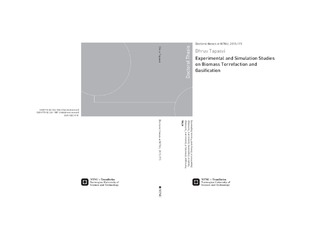Experimental and Simulation Studies on Biomass Torrefaction and Gasification
Doctoral thesis

Åpne
Permanent lenke
http://hdl.handle.net/11250/285982Utgivelsesdato
2015Metadata
Vis full innførselSamlinger
Sammendrag
The potential for bioenergy in Norway is significant. This potential can be realized by
improving the properties of biomass and making it a convenient and competitive alternative
to other fuels. Torrefaction is the most promising biomass pretreatment technique to date,
improving its effectiveness as a fuel in various thermochemical processes. Torrefaction
considerably reduces moisture content but increases the heating value, hydrophobicity and
grindability of biomass. Torrefaction is influenced by many parameters, including biomass
composition, temperature, holdup time and particle size. To evaluate the feasibility of
torrefaction in a particular region, locally available biomass resources should be investigated.
This approach forms the basis of the present study. To improve the viability of bioenergy in
Norway, I undertook fundamental research on the torrefaction of Norwegian woody biomass
and evaluated the behavior of torrefied biomass in thermochemical processes.
Starting with a detailed literature review on the topic, torrefaction behavior of Norwegian
Birch and Spruce was experimentally investigated. Torrefaction experiments were performed
in a macro-TGA reactor with provisions for continuous measurement of volatiles. Process
temperature (225 and 275 °C), holdup time (30 and 60 minutes) and sample size (10 and 40
mm cubes) were varied. Fuel characterization, derivative thermogravimetric (DTG) curves,
product yields, hydrophobicity tests, grinding energies and particle size distributions are
discussed. Temperature had the strongest effect on the properties of torrefied biomass of all
the studied parameters. Overall, considerable improvements in grindability and
hydrophobicity were obtained in torrefied biomass from both feedstocks.
To obtain information on the intrinsic kinetics of torrefaction, the pyrolysis kinetics of
Norwegian spruce and birch wood was investigated in another study. Micro-TGA was
employed with nine different heating programs, including linear, stepwise, modulated and
constant reaction rate (CRR) experiments. The 18 experiments on the two feedstocks were
evaluated simultaneously using the method of least squares. Part of the kinetic parameters
could be assumed common for both woods without a considerable worsening of the fit
quality. Three pseudocomponents were assumed. Two of them were described using
distributed activation energy models (DAEM), while the decomposition of the cellulose
pseudocomponent was described using self-accelerating kinetics. In another approach, all
three pseudocomponents were described using n-order reactions. A table was calculated to provide guidance about the extent of devolatilization during torrefaction at various
temperatures and residence times.
For understanding torrefied biomass reactivity in oxidative conditions, another micro-
TGA study was conducted with four torrefied wood samples and their original feedstocks
(birch and spruce) at slow heating rate programs. Particularly low sample masses were
employed to avoid self-heating of the samples due to heat of combustion. Linear, modulated
and CRR temperature programs were employed in TGA experiments under gas flows of 5
and 20% O2. The kinetic model consisted of two devolatilization reactions and a subsequent
char burn-off reaction. Cellulose decomposition in the presence of oxygen has selfaccelerating
(autocatalytic) kinetics. Decomposition of the non-cellulosic components of the
biomass was described using a distributed activation model. The char burn-off was
approximated by power-law (n-order) kinetics. Each of these reactions has its own
dependence on oxygen concentration, which was also expressed using power-law kinetics.
The model contained 15 unknown parameters for a given biomass. Certain of these
parameters could be assumed to be identical for the six samples without a substantial
worsening of fit.
Lastly, the behavior of torrefied biomass in a gasification process was evaluated. A twostage
biomass gasification model was selected using Aspen Plus as the simulation and
modeling tool. The model included minimization of the Gibbs free energy of the produced
gas to achieve chemical equilibrium, constrained by mass and energy balances for the system.
Air and steam were used as the oxidizing agents with both untreated and torrefied biomass as
feedstocks. Three process parameters were studied: equivalence ratio (ER), Gibbs reactor
temperature and steam-to-biomass ratio (SBR). A total of 27 cases were included in the
analysis, operating the system below the carbon deposition boundary with all carbon in the
gaseous form in the product gas. Product gas composition [hydrogen (H2), carbon monoxide
(CO), carbon dioxide (CO2) and nitrogen (N2)] was analyzed together with cold gas energy
and exergy efficiencies for all cases. Torrefied biomass gave higher H2 and CO contents in
the product gas, as well as higher energy and exergy efficiencies, than untreated biomass. The
overall efficiency of an integrated torrefaction-gasification process depends on the mass yield
of torrefaction. The results were validated using a C-H-O ternary diagram combined with
results from similar studies.
Består av
Paper 1; Tapasvi, Dhruv; Tran, Khanh-Quang; Wang, Liang; Skreiberg, Øyvind; Khalil, Roger Antoine. BIOMASS TORREFACTION – A REVIEW. 9TH EUROPEAN CONFERENCE ON INDUSTRIAL FURNACES AND BOILERSPaper 2: Tapasvi, Dhruv; Khalil, Roger Antoine; Skreiberg, Øyvind; Tran, Khanh-Quang; Grønli, Morten. Torrefaction of Norwegian Birch and Spruce: An Experimental Study Using Macro-TGA. Energy & Fuels 2012 ;Volum 26.(8) s. 5232-5240 http://dx.doi.org/10.1021/ef300993q © 2013 American Chemical Society
Paper 3: Tapasvi, Dhruv; Khalil, Roger Antoine; Várhegyi, Gabor; Tran, Khanh-Quang; Grønli, Morten; Skreiberg, Øyvind. Thermal Decomposition Kinetics of Woods with Emphasis on Torrefaction. Energy & Fuels 2013 ;Volum 27.(10) s. 6134-6145 http://dx.doi.org/10.1021/ef4016075 © 2013 American Chemical Society
Paper 4: Tapasvi, Dhruv; Khalil, Roger Antoine; Várhegyi, Gabor; Skreiberg, Øyvind; Tran, Khanh-Quang; Grønli, Morten. Kinetic Behavior of Torrefied Biomass in an Oxidative Environment. Energy & Fuels 2013 ;Volum 27.(2) s. 1050-1060 http://dx.doi.org/10.1021/ef3019222 Copyright © 2013 American Chemical Society
Paper 5: Tapasvi, Dhruv; Kempegowda, Rajesh Shivanahalli; Tran, Khanh-Quang; Skreiberg, Øyvind; Grønli, Morten. A Simulation study on the torrefied biomass gasification. Energy Conversion and Management 2014 ;Volum 90. s. 446-457 http://dx.doi.org/10.1016/j.enconman.2014.11.027 This article is reprinted with kind permission from Elsevier, sciencedirect.com